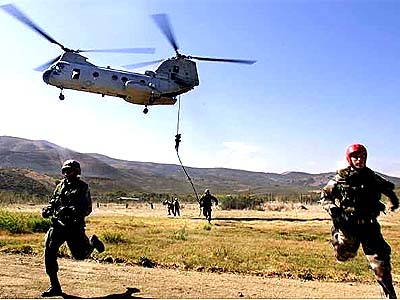 A discussion with Al Carroll (Mescalero Apache):
A discussion with Al Carroll (Mescalero Apache): A discussion with Al Carroll (Mescalero Apache):
A discussion with Al Carroll (Mescalero Apache):
Hi again Rob,
I'm writing a paper on Native and pseudo-Indian images and names in the military. To my knowledge it's never been researched or written about, except briefly touched on by military enthusiasts who collect memorabilia. I'm comparing it to the mascot issue and looking at the ways these images and names are sometimes different from sports mascots, but more often are not. Your website was a goldmine of links on the mascot issue. Keep up the good work, and thanks.
But I'd also like to hear your thoughts and those of your readers on the subject of "Indian" symbolism and names in the military, maybe start a discussion on the issue.
To my knowledge, only one "Indian" image in the military has ever been the subject of protests, the Air Force "chiefs" groups. These are informal fraternal type hazing outfits. When you reach the rank of Chief Master Sgt. in the AF, on many bases you are expected to attend these "ceremonies" where you wear a warbonnet and take a "chief's oath." A perfect candidate for your stereotype of the month contest I think.
So far in my research I've found dozens of units with either Native or pseudo-Indian symbolism, ranging from very respectful and traditional images chosen by Native people to the blatantly insulting and racist.
The former I refer as actual Native images. A good example is the 81st Washington Nat'l Guard Infantry Brigade symbol of a raven done in traditional Northwest Coast style of artistry. Another would be the 45th Army Division symbol of a Thunderbird. The 45th also started off as a NG unit with members from AZ, NM, CO, and UT with 1/5 of its soldiers being Natives. In my paper I'm going to argue there is a huge difference between military images chosen by Native people or people with long contact with us and those picked out by people who have almost zero understanding or contact with us.
The latter kind of images are far more common in the military. Probably the worst I've come across is a WW2 unit that called itself the "Injun-eers." The Peoria Air National Guard unit is a close second, showing a Disney-esque fat "Indian" wearing a pilot's cap with horns (?) attached. It's interesting to note this unit is stationed close by to a university where the mascot issue has been pretty contentious, the University of Illinois and their "Fighting Illini" and the "chief."
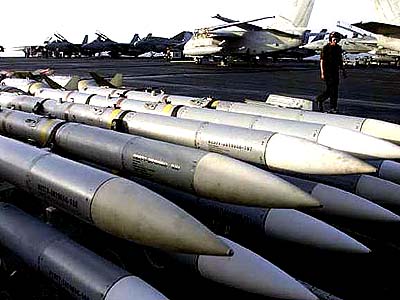
As far as names, most of your readers can think of plenty of examples of Indian names of warships and other weapons. I've found dozens of examples of Indian naming of warships going back to at least the 1820s. The Royal Canadian Navy even has an official policy since WW2 of naming warships after tribes. The US Army also has an official reg actually called the "Nothing But Indians" memo that has required since 1968 that all Army helicopters be named after tribes or individual famous Natives.
There are some cases of Navy ship names that were expressly designed to honor the memory of famous Natives such as the USN RedCloud. It was named for Mitchell Red Cloud, a Korean War Ho-Chunk soldier who was awarded the Medal of Honor posthumously, and has the approval of his family. But these are relatively rare.
I have some hypotheses as to why pseudo-Indian names and symbols have not been protested like sports mascots. It seems to me that:
1) Protesters have focused on images and practices that insult Native spiritual beliefs, such as the tomahawk chop, fans wearing "warpaint," and mascots dressed as "chiefs." Outside of the AF "chiefs," none of these happen in the military.
2) Protesters (naturally) especially object to images that push these ideas to children.
3) Protesters are especially angry when someone makes a profit (huge profits in the case of sports teams) off of degrading Native people.
4) The military is an institution highly respected by most Native people that has benefited Native peoples by providing an outlet for recognition of warrior traditions within Native communities, education and training, etc. Outside of a tiny number of Native athletes, sports teams have never benefited Native communities.
5) The structure of the military discourages protests by the people who know about these images. I and most other native vets I've talked to or read their accounts of service for my research recall being called chief, Geronimo, blanketass, raindancer, etc., but usually chose to avoid confrontations and just put up with it. Ira Hayes even had to put up with it. I'd generally avoid anyone who said that to me and leave it at that. Most others had the same way of dealing with it. Changing the insignias of units would take lots of butting heads with officers and NCOs, something anyone who's been in the service knows you want to avoid.
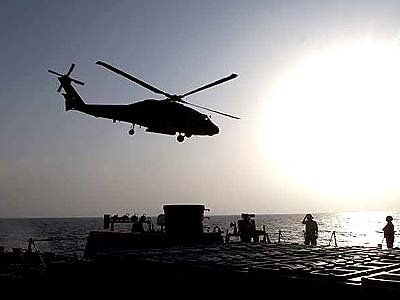
I'm curious as to whether any of your readers will bring these up, either agree with or dispute them. And what your own opinions are. Feel free to publish this letter on your site.
Thanks again for all the good work you do,
Al Carroll (Mescalero Apache, ex-Army)
Phd student, Arizona State
bigi__@yahoo.com
Rob's reply
I haven't said anything major on the Indian/military connection, but I've mentioned it a couple of times. See the postings at Smashing People: The "Honor" of Being an Athlete and Fighting Sioux vs. Fighting Irish for examples.
Have you heard that US soldiers in Vietnam sometimes called enemy territory "Indian country"? I even saw the term in an X-MEN comic in 2001. I think you should include that in your study. It speaks to the whole "warrior" issue—the same issue that arises with mascots.
Namely, we say we're naming our mascots after Indians because they were brave and bold warriors. But most people who fought in wars weren't just symbols of courage. They maimed or killed people to achieve their goals. Since war is ultimately about killing, one could say all warriors have blood on their hands by definition.
That explains why we'd associate our military opponents with "Indian country." We believe everything we do is good, so everything our opponents do must be bad. Only someone who is savage, inhuman, or evil would fight our "just" cause.
In short, we name sports teams, weapons and crafts, and enemy territory after Indians because they represent violence and death to us. The so-called honor isn't that honorable, either in sports or the military.
Why don't Native people protest the military stereotypes? I'd guess it's an amalgam of your reasons. Indians like to think of themselves as warriors because the image is superficially positive....because it affirms their worth...and because our society values it. They have more important problems to deal with than military images...or commercial images such as Indians selling Jeeps, motorcycles, or beef jerky...or even some sports mascots (you'll notice they reserve the worst ire for vulgarities such as the Washington Redskins, Chief Wahoo, and Chief Illiniwek). Finally, as some Native children said about Indian mascots, it's better to be stereotyped than to be invisible.
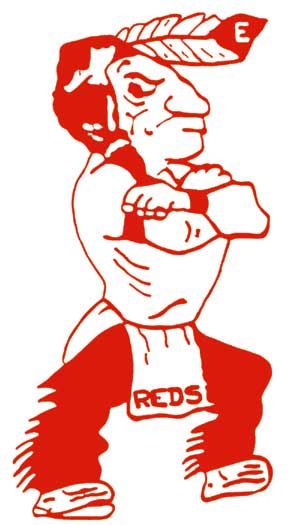
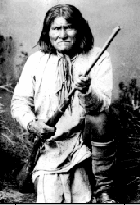
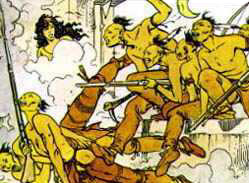
Holm confirms military/mascot link
Dear Rob,
Richard Allen, my friend and fellow Marine at Cherokee Nation, passed along your site. Since I was quoted I thought I'd throw in a couple of cents worth of opinion. I think that the warrior/savage/mascot/military stereotypes are linked. To many white Americans, Native peoples were the principal opponents of the Euro-American conquest of North America. This conquest has been made into an epic of individual bravery, farsightedness, and self-sacrifice against a savage, militarily adept, merciless, and brave foe. If we Natives had been a bunch of pacifists, the American national saga of conquest would have no great spiritual or symbolic meaning. Expansionism really was a tawdry affair of land swindles, double-dealing, fraud, murder, power plays, greed, and theft. Americans have understandably turned reality into a glorious blood sacrifice in which Indians played a major role.
The stereotypes and the notion that Natives inherently possess a kind of martial expertise only serve to recall and celebrate this American epic. When a lieutenant in Korea sent a Native to walk point on a patrol, he was recalling a stereotype in the American epic that portrayed "the Indian" (a European term) as a stealthy hunter and warrior, steeped in the knowledge of the terrain and attuned to the normal sights, sounds, and smells of the landscape. An Indian would notice anything out of place or unusual. When a crusty Gunnery Sergeant in Vietnam told a new group of boots to the bush that "out there is Indian country and this is Fort Apache," he was reminding them that if stalwart Americans can overcome Indians in the American saga, they could surely vanquish another sneaky, non-white, but ultimately dangerous enemy. And when the local high school football team named "the Braves," or "the Chiefs," or "the Indians," charges onto the field behind a mascot bearing the name "Chief Yoyo" or "the fighting Apache," the fans in the stands are not "honoring" Indians, they are really celebrating the American myth that says these brave, savage warriors were overcome only by white American tenacity, skill, and courage.
White Americans created the saga and the stereotypes. Because they did so, they literally think they own them and feel as if they can use them in any way they please. The attitude is understandable perhaps, but not particularly edifying.
What do you think?
Tom Holm, author, Strong Hearts, Wounded Souls: Native American Veterans of the Vietnam War
I think you've nailed it, Tom. An excellent explication of why associating Indians with warriors isn't necessarily an honor. See Smashing People: The "Honor" of Being an Athlete for more on the subject.

More agreement with Holm
From Al Carroll:
I definitely agree. I think the use of images of "the Indian" in both sports images and military symbols are ways for Anglos to give themselves a license to be violent, or at least enjoy spectacles of violence, whether it's watching "Cowboys Skin Redskins" as one newspaper headline trumpeted, or watching CNN depict the Gulf War as one big video game.
Many observers have commented on how old western movies rationalized the murder of people of certain ethnicities, not just Indians but often Mexicans as well. Can you imagine a genre of movies glamorizing the killings of slaves in revolts, or the lynchings of newly freed slaves, as somehow necessary for nation-building? ("Birth of a Nation" probably came the closest to the latter, but the fact that such a genre is almost unthinkable says quite a lot about how Anglos are at least more able to come to grips with blacks as people seeking equality while Natives must wade through a more formidable host of misconceptions.)
Probably the most bizarre cases of Anglo perception of us all as "natural warriors" or "super scouts" came after World War One. Lt. Ray Duncan performed a series of tests which he claimed "proved" Indians could actually see in the dark and always knew which way was north without a compass.
Joseph Dixon, the most famous of all the self styled Friends of the Indian, actually proposed in testimony before Congress that all Native males be required by law to attend military school from ages 8 to 18. Upon turning 18, Native males would then be required to join segregated Native units of (naturally) cavalry and serve until age 40. "By no stretch of the imagination can we conceive of the Indian as a pacifist...he is a great fighter, a natural scout, and a born hater...we must act before we no longer hear the fading moccassined footsteps of a noble people." (This, as best I recall, is his testimony.)
Dixon's proposal was only defeated because of opposition from Cato Sells and others who thought war would be a civilizer. While it may be tempting to dismiss Duncan, Dixon, and Sells as racists typical of their time, one should think back to an Arnold Schwarzenneger movie, "Predator." In that movie is a character named Corporal Billy Bear. He is a typically stoic Indian for most of the movie, could have come stright out of the old westerns. At the end he becomes fatalistic and eager to die. He is even depicted as able to see and sense things no white soldier can see. And this movie was made in 1989.
Al Carroll
More on Indian stereotypes in the military
Book explores military stereotypes
McKinley says no to Indian imagery
NORAD Drops Terms
Military Commands Drop Indian Terms From Exercise Titles
The Air Force and Indian Imagery: Top officer calls for abolishing insignia
Examples of Indian stereotypes in the military
Enemy territory as "Indian country"
Indian nicknames for military craft
Native veterans in fiction
Windtalkers: no guts, no glory
Mauldin's antiwar Indian Willie
Who's the semi-nude Indian maiden?
More on Indians in the military
Warriors honor warriors
Native version of The War
Army seeks Indian soldiers
Indians die in Iraq
Why Indian vets get stressed
Lakota vet opposes war
Indians rethink the military
Related links
Indians as warriors
Savage Indians
Team names and mascots
|
. . . |

|
All material © copyright its original owners, except where noted.
Original text and pictures © copyright 2007 by Robert Schmidt.
Copyrighted material is posted under the Fair Use provision of the Copyright Act,
which allows copying for nonprofit educational uses including criticism and commentary.
Comments sent to the publisher become the property of Blue Corn Comics
and may be used in other postings without permission.